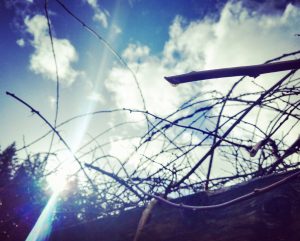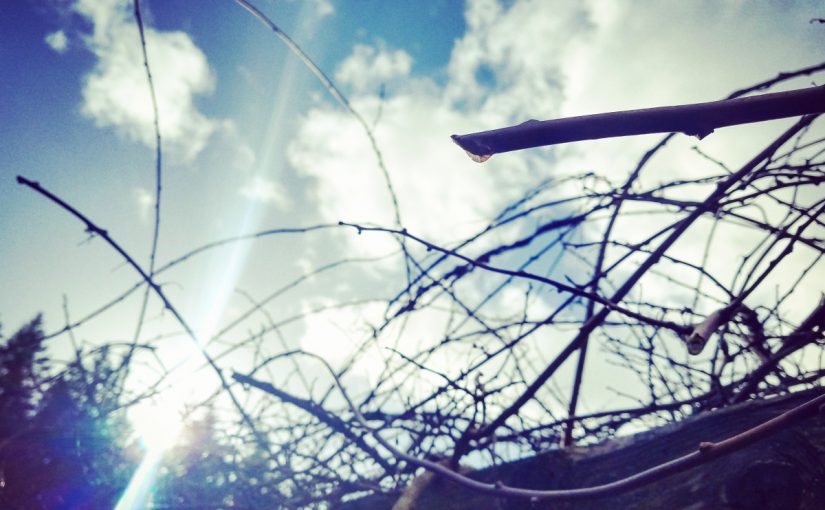Several of the hardy kiwi plants at the Organic Farm are of unknown age, but they are likely to be at least 10 years old.
Two more female plants were put in the ground last year by the POF class and the trellis was expanded for them. Of the older plants, there are two female and one male- the male plant does not fruit, but it fertilizes the female plants so they will produce fruit. Unfortunately, one of the female plants was damaged while it was being pruned back a couple of years ago and it has not produced fruit since. The other mature female kiwi produces well; over 80 pounds of kiwi berries last year! The older plants are in desperate need of pruning, and I will attempt to outline my suggested procedures to do so in this paper.

The optimal time for pruning kiwi is in the dormant season, December and January. During this time, the sap flow will slow. Pruning while the sap is readily flowing can weaken and cause damage to the vines, which could impact fruit production or even kill the entire plant. Assuming the plants at the Organic Farm are dormant, I would first look for dead and/or decaying vines and remove those, along with any vines that have been wind damaged or otherwise look unhealthy. After the dead and decaying vines are taken off, I would next look for vines that are wrapped around each other- these vines are likely to choke each other out and eventually die, so they should be removed in order to thin out the plant and promote good air circulation and sun exposure. Special care should be taken to not remove spurs, as these are where bunches of fruit will grow during the summer and removing them will negatively impact fruit production. Once the dead vines and choking vines have been removed, I would then look to find last year’s fruiting canes and remove them, leaving a replacement cane to encourage fruit growth for the coming season. Replacement canes should also be given a heading cut to encourage growth. Once all of these cuts have been completed, the female kiwi plants should be in pretty good shape for the coming fruit-growing season. Further thinning and pruning of the plants can occur again next year; it is important to prune kiwis regularly to keep them manageable and healthy.
Male kiwi plants don’t need a ton of pruning, as they don’t fruit and therefore don’t require excessive thinning. The ultimate goal when pruning male vines is to encourage as much flower growth as possible, as it is the flowers that produce pollen and then fertilize the female plants. Male plants should also be relieved of damaged and dead vines and any vines that are twisted and tangled and likely to choke out viable plant tissue. Attention should be paid to thinning vines enough to create a plant with good sun exposure so flowers will bud and bloom. After a cursory trim, male kiwi plants should be regularly pruned back in the dormant season to keep them manageable along with the female plants.
The hardy kiwi vines at TESC’s Organic Garden are a disheveled mess, but with several years’ worth of dedicated pruning and training, I believe they can once again return to a manageable state. Along with becoming more manageable, the plants should also become more fruitful and will hopefully produce even more fruit than the 80 pounds harvested last year.
